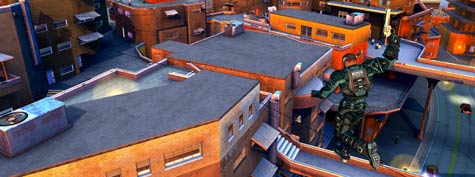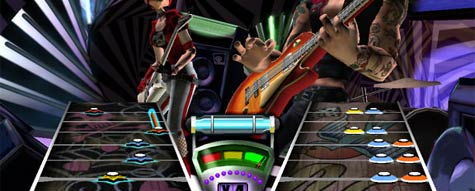
Crackdown seems so unremarkable to begin with. A large city; free-roaming run, gun, and drive action; roughly-stereotyped gangs that need taking down. That hint of cel-shading isn’t enough to lift it in your opinions.
And then you start to level up, and the game unveils its true majesty. When that comes, it’s hard to say: perhaps it’s when you turn to face a carful of Los Muertos thugs and just pick the car up, with them in it, and hurl it off a bridge. Perhaps when you leap from one ten-storey building to another, raining death from above on casual gang members. Perhaps when you stop “playing” the game, and take the time to go for a run.
Like San Andreas before it, Crackdown allows your character to level up abilities; but unlike San Andreas, Crackdown takes the physical limits of your character well into superhero territory. And when that happens, the city that is the game’s playscape transforms.
From street-level, it seems perhaps bland, stereotyped; it doesn’t have the instantly familiar locations (as Dan Hill points out in a marvelous City of Sound post) that Rockstar is so capable at creating, and is perhaps harder to navigate as a result. But as your agility increases, the streets fade away as you spend more of your time on the rooftops. From above, everything makes so much sense; it’s a much higher-rise environment, full of windowledges and awnings, offering handholds to reach you to the skies. And then the traditional structure of the city falls apart. No longer is it delineated by roads and pavements, and obstructed by buildings; the buildings themselves become the fabric, as you leap from roof to roof, impervious to the regimented town planning below. In so many ways, it’s Grand Theft Parkour : like the traceur, your agent deconstructs the urban environment, remaking it in a shape he prefers.
I can’t help but call to mind this Frieze article about the Israeli Defence Force, describing the process by which they (literally) deconstruct the city in order to move through it, ignoring existing paths to create their own. Through that, the soldiers gain…
a conception of the city as not just the site but also the very medium of warfare – a flexible, almost liquid medium that is forever contingent and in flux.
And, of course, that’s exactly the sensation Crackdown generates – the feeling that you are no longer moving through the city, but that you are moving the city around you.
It’s then that the other subtleties of Crackdown rear their heads. The fact there’s no traditional meet-a-guy-and-get-a-mission-structure – it’s all radioed in to you, meaning you can ignore it from the get-go; whilst completing the missions will earn you experience on the way, the city is truly free-roaming from the start. The mini-map, initially perhaps too small, too clumsy, pales into insignificance as you become more agile; a far better perspective on your destination can be had from scaling the nearest tower block.
And, of course, there’s no better way of playing about in an unfamiliar city than with a friend. Crackdown supports a co-operative mode, and it’s a real treat: almost entirely lag-free, with the whole city to roam in, it captures the joy of playing with someone else perfectly. Alex and I spent a good hour of the demo charging around the city to absolutely no end, taking it in turns to set up piles of cars to perform ludicrous stunts, and charging about over the rooftops looking for fun “lines” and new challenges. Like I said: fun.
Crackdown will shift a lot of copies when it’s released later this month, because it includes a free invite to the Halo 3 beta. Hopefully, Halo fans will take the time to play the game they shelled out for, because it’s shaping up to be very fine in its own right. Whilst perhaps not as polished or slick a game as Rockstar’s classics, it refines the urban-sandbox genre – mixing in the athleticism and playfulness of Spiderman 2 and Hulk: Ultimate Destruction – and stands strong in its own right. Crackdown encourages – and, to be honest, demands – to be played. And isn’t that what games should be about?
